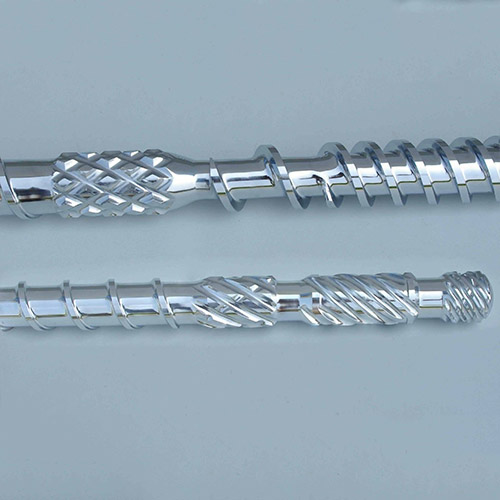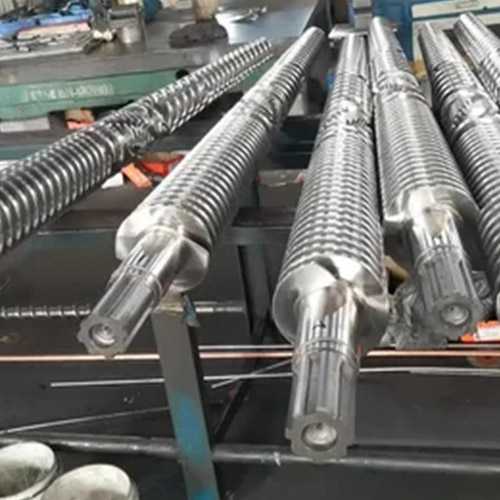04-01, 2021
The combination quality of screw and barrel has an important influence on material plasticization, product quality and production efficiency. Their working quality is related to the manufacturing accuracy and assembly clearance of the two parts. When the two parts wear seriously and the output of extruder decreases, the maintenance of screw and barrel should be arranged.
1、 Damage causes of screw and barrel
1. When the screw rotates in the barrel, the friction between the material and the two causes the working surface of the screw and barrel to wear gradually: the diameter of the screw is gradually reduced, and the diameter of the inner hole of the barrel is gradually increased. In this way, the fit diameter gap between screw and barrel increases with the gradual wear of the two. However, because the resistance of the head and splitter plate in front of the barrel does not change, the leakage flow of the extruded material is increased, that is, the flow of the material from the diameter gap to the feed direction increases. As a result, the output of extruder decreased. This phenomenon also increases the residence time of materials in the barrel, resulting in the decomposition of materials. In the case of polyethylene, the hydrogen chloride gas produced by decomposition strengthens the corrosion of screw and barrel.
2. If there are fillers such as calcium carbonate and glass fiber in the material, the wear of screw and barrel can be accelerated.
3. Because the material is not plasticized evenly, or there are metal foreign bodies mixed into the material, the screw torque suddenly increases, which exceeds the strength limit of the screw and makes the screw break. This is an unconventional accident damage.
2、 Repair of screw
1. The twisted screw should be considered according to the actual inner diameter of the barrel, and the outer diameter deviation of the new screw should be given according to the normal clearance with the barrel.
2. After treatment, the surface of thread with reduced diameter of worn screw is sprayed with wear-resistant alloy, and then ground to size. This method is usually processed and repaired by a professional spraying Factory, and the cost is relatively low.
3. Wear resistant alloy is overlaid on the thread of worn screw. According to the wear degree of the screw, surfacing 1 ~ 2mm thick, and then grinding the screw to the size. The wear-resistant alloy is composed of C, Cr, VI, Co, W and B, which increases the wear resistance and corrosion resistance of the screw. The cost of this kind of processing is very high in professional surfacing plant, except for the screw with special requirements, it is rarely used.
4. Hard chromium plating can also be used to repair the screw. Chromium is also a wear-resistant and corrosion-resistant metal, but the hard chromium layer is easy to fall off.
3、 Repair of cylinder
The inner surface hardness of the barrel is higher than that of the screw, and its damage is later than that of the screw. The scrapping of barrel is the increase of inner diameter due to time wear. Its repair methods are as follows:
1. If there is a certain nitriding layer in the cylinder with increased diameter due to wear, the inner hole of the cylinder can be directly bored and ground to a new diameter, and then a new screw can be prepared according to this diameter.
2. The inner diameter of the barrel is machined and trimmed, the alloy is cast again, and the thickness is between 1 ~ 2mm, and then finished to the size.
3. Generally, the homogenizing section of the barrel is worn fast. This section (5 ~ 7d long) can be finished by boring, and then equipped with a nitrided alloy steel bushing. The inner hole diameter refers to the screw diameter, and the normal fit clearance can be left for processing and preparation.
Here we emphasize that the screw and barrel are two important parts, one is a slender threaded rod, the other is a relatively small and long diameter hole. Their machining and heat treatment processes are complex, and it is difficult to guarantee the accuracy. Therefore, whether to repair or replace the worn parts must be analyzed comprehensively from the economic point of view. If the cost of repair is lower than that of replacement, it is not necessarily the right choice. The comparison between the cost of repair and that of renewal is only one aspect.



